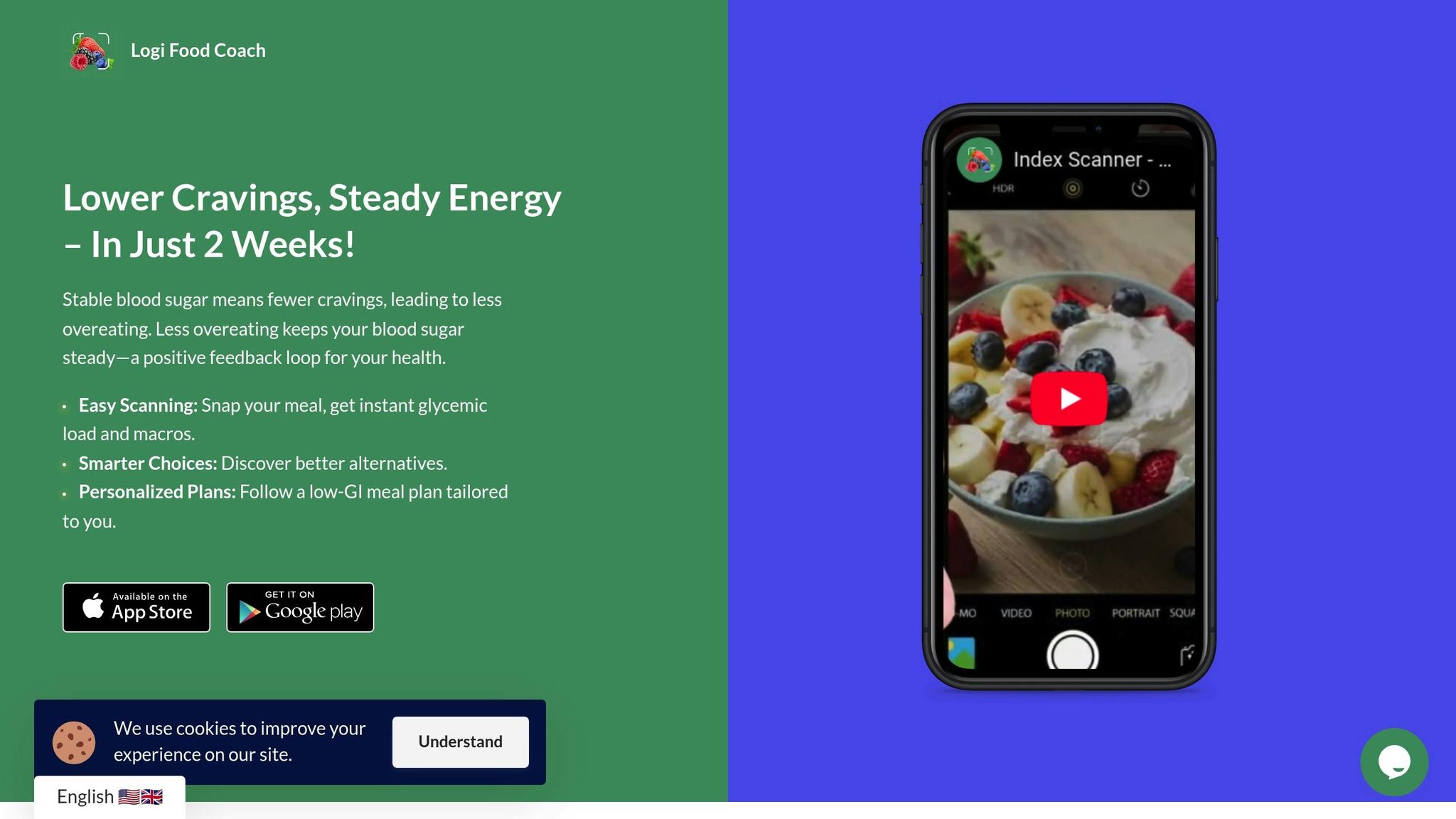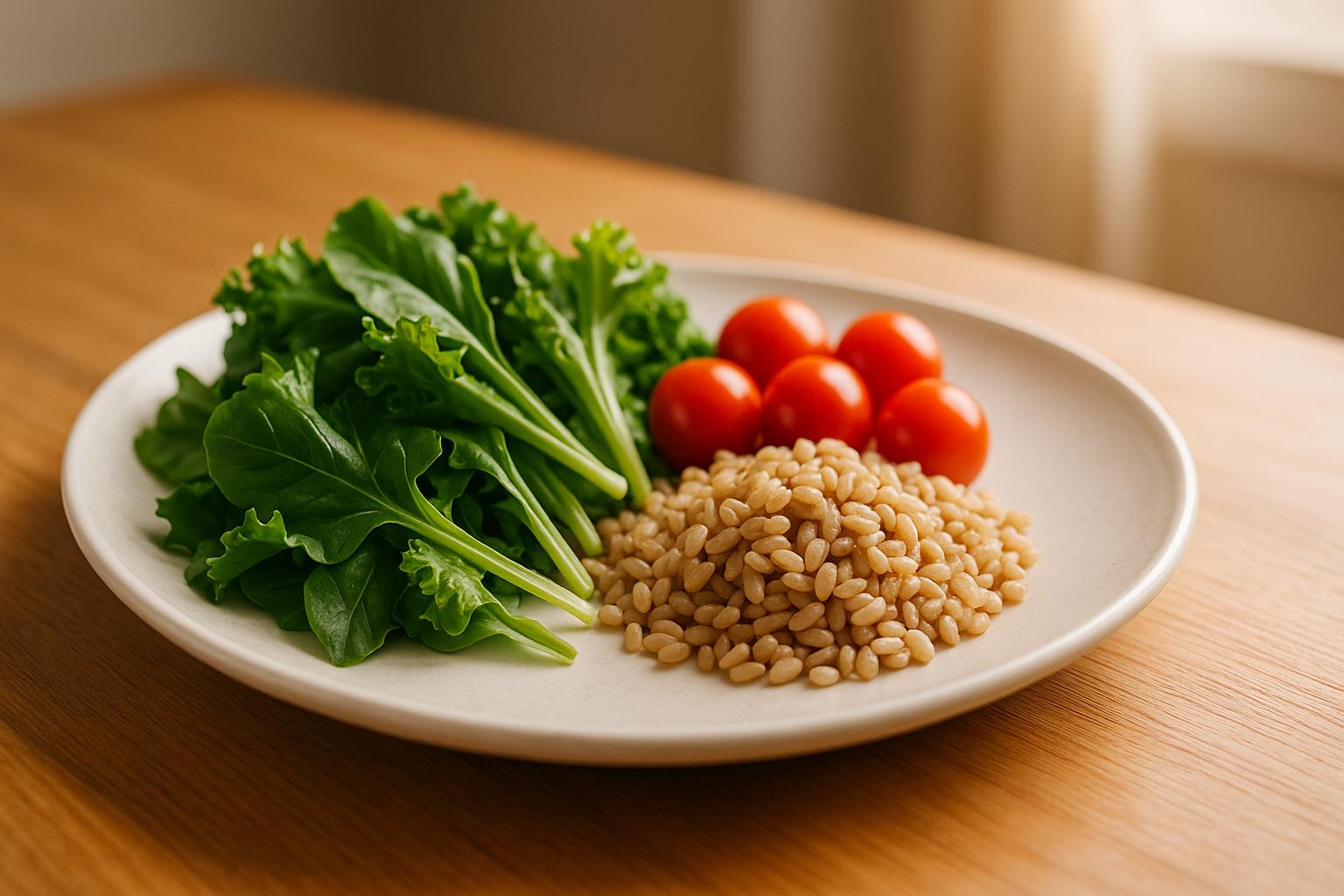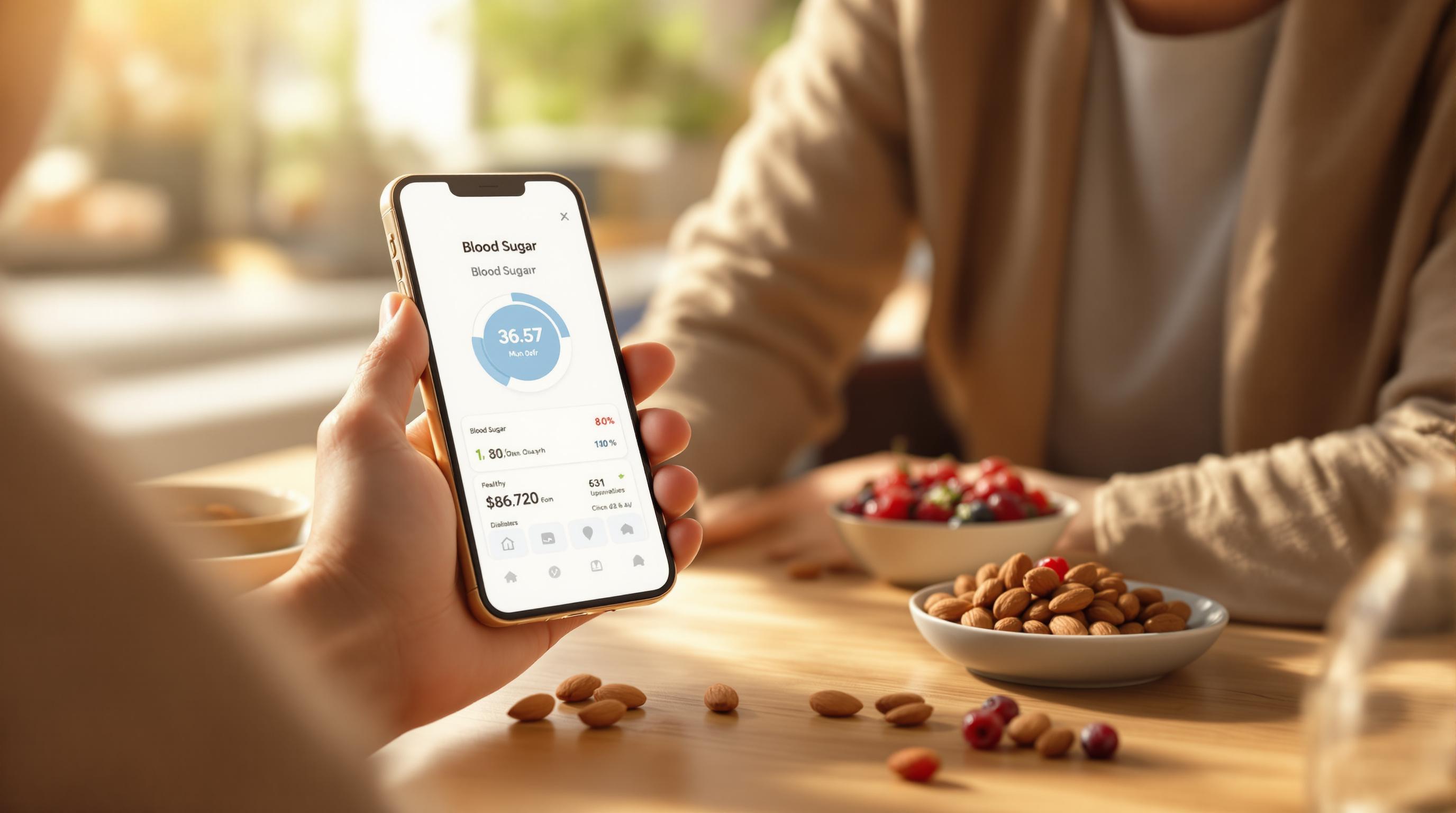Exercising after meals can help manage blood sugar levels effectively, especially for those with diabetes or prediabetes. Timing plays a key role: light activities like walking 30–90 minutes after eating align with blood sugar peaks, making it easier for muscles to absorb glucose. This approach supports steady energy, better digestion, and overall metabolic balance.
Here’s what you need to know:
- Blood sugar spikes 60–90 minutes after eating, especially with high-GI foods.
- Light to moderate exercise during this window (e.g., a 10–15-minute walk) helps reduce spikes.
- Avoid intense workouts immediately after meals, as they may interfere with digestion.
- Tools like Logi can track your meals and suggest optimal exercise timing.
Consistency is key. Even small, regular post-meal movements can improve blood sugar control over time.
10 Min After Eating Walking Workout | GENTLE Exercise to Lower Blood Sugar
What Research Shows About Exercise Timing and Blood Sugar
Recent studies are shedding light on how the timing of exercise after meals can impact blood sugar control. The findings suggest that waiting a short period before engaging in physical activity may lead to better glucose management. Below, we’ll dive into the differences in timing, individual responses, and the current gaps in research.
Exercising Immediately vs. Waiting a Short Period
When it comes to managing blood sugar, timing matters. Research indicates that waiting a brief period after eating before starting moderate exercise can lead to better results. One study found that delaying exercise helped achieve sharper reductions in blood sugar peaks. This is because allowing some time for digestion aligns rising blood sugar levels with the body’s glucose uptake during activity. Even something as simple as a light walk after a meal can help smooth out post-meal blood sugar spikes.
How Different People Respond to Exercise Timing
The benefits of post-meal exercise timing are particularly noticeable in people with type 2 diabetes or prediabetes. While individuals with normal glucose tolerance may still experience advantages - like improved energy balance and metabolic support - the effects can vary. Factors such as age, baseline insulin sensitivity, and overall health also play a role in how someone responds to exercise timing.
What Current Research Cannot Tell Us
Although the findings so far are encouraging, there are still gaps in the research. Many studies rely on small sample sizes and short timeframes, making it hard to draw conclusions about long-term effects. Additionally, most of the research focuses on light to moderate activities, leaving the impact of higher-intensity exercise largely unexplored. Individual differences, including genetics, medications, and lifestyle habits, further highlight the need for broader studies to understand how exercise timing fits into everyday life.
How Exercise Timing Changes Blood Sugar in Your Body
This section dives into why the timing of exercise after meals can significantly impact blood sugar control, based on how your body processes glucose.
How Muscles Use Sugar During Exercise
When you exercise, your muscles become glucose powerhouses, pulling sugar from your bloodstream without needing insulin. This happens because physical activity activates proteins that help transport glucose into your cells. This process is especially helpful for people with insulin resistance and also improves muscle insulin sensitivity for several hours after you finish exercising.
Exercising When Blood Sugar Peaks
Blood sugar levels typically hit their highest point about 60 to 90 minutes after eating. Exercising during this window can help your body absorb glucose more efficiently, reducing the intensity of the spike. Even light movement during this time, like a leisurely walk, not only aids in glucose management but also supports digestion.
Light Walking vs. Hard Exercise After Meals
The type of exercise you choose after a meal matters. Light to moderate activity - like a 10- to 15-minute walk - promotes steady glucose absorption without interfering with digestion. On the other hand, intense workouts can redirect blood flow away from your digestive system and trigger stress hormones, which might temporarily elevate blood sugar levels.
Moderate activities, such as casual cycling, light jogging, or even tidying up around the house, offer a great middle ground. They enhance glucose uptake while keeping your digestive system on track. Even just 10 minutes of light movement can make a noticeable difference in how your body handles post-meal blood sugar.
sbb-itb-0899721
How to Time Your Exercise After Meals
Figuring out when to exercise after eating can make a big difference in how your body feels and responds. By aligning your activity with digestion and blood sugar patterns, you can get the most out of your post-meal routine without discomfort.
Best Times to Start Exercising After Eating
When it comes to lighter activities like walking, you can usually start shortly after eating without any issues. But if you’ve had a heavier, richer meal, giving your body a bit more time to kickstart digestion can help you avoid feeling sluggish or uncomfortable.
For moderate exercise, waiting a little longer can be beneficial. This timing often matches the natural rise in blood sugar, allowing your muscles to use that glucose efficiently. Carbohydrate-heavy meals tend to spike blood sugar faster, while protein-based meals may lead to a slower, steadier increase. Adjust your start time based on what you’ve eaten and how your body feels.
How Long and How Hard to Exercise
Once you’ve nailed down the timing, it’s important to pick the right duration and intensity. A 10- to 30-minute session of light to moderate activity is a good starting point. Activities like a casual walk or gentle cycling are excellent options for post-meal movement and can help regulate blood sugar without straining your digestive system.
For those managing diabetes or prediabetes, it’s wise to consult a healthcare provider about what kind of exercise - and how much - is safe for you. High-intensity workouts right after eating aren’t ideal, as they can release stress hormones that might temporarily raise blood sugar levels. Stick to moderate activity to keep things balanced.
Staying Safe During Post-Meal Exercise
If you’re on blood sugar-lowering medications, exercise can amplify their effects. It’s a good idea to check with your healthcare provider about any necessary adjustments to your medication timing or dosage. Always monitor your blood sugar before and after exercising, and make sure to stay hydrated, especially if you’re trying out a new routine.
Start small - maybe with a short walk - and gradually increase the duration as your body gets used to it. Pay attention to how you feel. A little fullness is normal, but if you experience nausea, cramping, or dizziness, it’s a sign to slow down or take a break.
If you have diabetes, keep a quick source of carbs, like glucose tablets or a small snack, nearby just in case. And don’t forget to adapt your routine based on the weather. On hot or cold days, indoor activities or exercising during milder times can help you stay comfortable and safe.
Using Logi to Track and Improve Post-Meal Blood Sugar Control

Logi takes the guesswork out of managing your blood sugar after meals by combining research-backed insights with practical tools. It helps you understand how different foods impact your glucose levels and when to exercise for better control.
Track Glycemic Load and Understand Meal Impact
Logi’s meal glycemic load scanner makes it easy to see how your food choices affect your blood sugar. Instead of memorizing complicated charts or doing mental calculations, you can simply scan your meal and instantly get its glycemic load and nutritional breakdown.
The app’s daily meal tracker lets you monitor how specific foods influence your energy throughout the day. For example, you might notice that your go-to breakfast sandwich causes a larger blood sugar spike than expected, while adding a protein source to your lunch keeps your levels steadier. This type of information becomes incredibly useful when planning post-meal activities.
By combining nutritional analysis with glycemic data, Logi highlights trends you might not notice on your own. For instance, meals high in fiber can provide sustained energy for exercise, while processed foods might leave you sluggish, even after a walk. Over time, the app helps you fine-tune your eating and exercise habits for better blood sugar control.
These tools create a foundation for personalized exercise timing recommendations.
Receive Tailored Exercise Timing Suggestions
Logi goes beyond tracking by offering personalized exercise timing recommendations based on your eating habits. It factors in the glycemic load of your meals, your typical blood sugar response, and your preferred activities.
For instance, if oatmeal is your usual breakfast, Logi might suggest taking a light walk about 45 minutes later, when your blood sugar is likely to peak. On the other hand, if you opt for eggs and toast, it could recommend starting your walk after just 30 minutes, since protein tends to cause a slower glucose rise.
The app also includes a low GI/GL food alternatives finder, which helps you make smarter meal choices that align with your exercise plans. For example, if you’re planning a bike ride an hour after lunch, Logi can suggest lower glycemic options that won’t leave you feeling overly full or lead to uncomfortable glucose swings during your ride.
By consistently following these tailored suggestions, you can build a reliable routine for managing post-meal blood sugar.
Long-Term Tracking and Insights
Over time, Logi creates a clear picture of how your meals and exercise routines affect your blood sugar. For example, you might find that certain breakfast choices consistently leave you feeling more energized for afternoon walks. These insights, made possible through detailed tracking, allow you to fine-tune your habits for better results.
Additionally, the app helps you see how your post-meal exercise patterns influence your overall blood sugar stability. Are your glucose levels becoming more consistent? Are you avoiding energy crashes? These trends not only keep you motivated but also provide valuable feedback for adjusting your approach.
For those managing diabetes or prediabetes, the glycemic load tracking over time feature is especially helpful. You can share this data with your healthcare provider to demonstrate how your lifestyle changes are improving your blood sugar control. This makes it easier to adjust medications or treatment plans to support your long-term health goals.
Key Points About Post-Meal Exercise and Blood Sugar
Here’s a quick rundown of how post-meal exercise can help you manage blood sugar levels effectively. Research consistently shows that exercising 30–90 minutes after eating aligns with peak blood sugar levels, making it the ideal time for your body to use glucose efficiently.
A simple 10 to 15-minute walk after meals can make a big difference. This light activity helps most people - whether dealing with diabetes, prediabetes, or just aiming for steady energy levels throughout the day - promote better glucose management.
The benefits of post-meal exercise can depend on factors like what you ate, your fitness level, and your metabolism. Everyone’s body responds differently, so tracking your habits can help you figure out whether moving earlier or later works better for you. Over time, you’ll notice patterns that make it easier to predict the best time to get moving.
Digital tools can simplify this process. Apps like Logi analyze your meal’s glycemic load and suggest personalized exercise windows. Instead of guessing when your blood sugar might peak, these tools provide tailored recommendations based on your food choices and eating habits.
Be cautious about jumping into vigorous exercise right after a large meal - it can lead to discomfort and even cause glucose spikes. Start with gentle movement, like walking or stretching, and gradually increase intensity as your body adapts to this routine.
Consistency is more important than nailing the perfect timing every day. Building a habit of post-meal activity - whether it’s a short stroll or light stretches - can lead to meaningful, long-term improvements in blood sugar control. The trick is to find what works for your lifestyle and stick with it, without adding unnecessary stress.
Pairing thoughtful food choices with well-timed physical activity creates a powerful approach for keeping blood sugar stable and maintaining steady energy throughout the day.
FAQs
Why is it best to wait 30–90 minutes after eating before starting light to moderate exercise?
Waiting about 30 to 90 minutes after eating before starting exercise can help your body regulate blood sugar levels more efficiently. During this window, your body works on digesting the food and stabilizing glucose levels, which lowers the risk of experiencing low blood sugar (hypoglycemia) during your workout.
Engaging in light to moderate activities, like walking, after this digestion period can further promote stable blood sugar without putting too much strain on your body. This approach strikes a balance between digestion and energy use, helping you stay active while feeling good.
How does the Logi app support better blood sugar control through exercise timing?
The Logi app is designed to help you take control of your blood sugar levels by offering glycemic load and index data for your meals. It also helps you plan exercise sessions at the best times based on your body's needs. By monitoring your eating habits and providing tailored insights, Logi makes it simpler to sync your physical activity with your blood sugar patterns, boosting both your energy and overall well-being.
What are the risks of doing intense exercise right after eating, especially for people with diabetes or prediabetes?
Engaging in intense exercise right after eating can pose risks, especially for those managing diabetes or prediabetes. One key concern is hypoglycemia (low blood sugar), which can happen if you're using insulin or medications that lower blood sugar. On the other hand, high-intensity workouts immediately following a meal might cause a temporary spike in blood sugar due to the body's natural counterregulatory response, leading to fluctuations that are tougher to control.
To minimize these risks, try to schedule workouts at the right time and stick to moderate-intensity activities after meals. This can help keep blood sugar levels more stable while promoting overall well-being.



